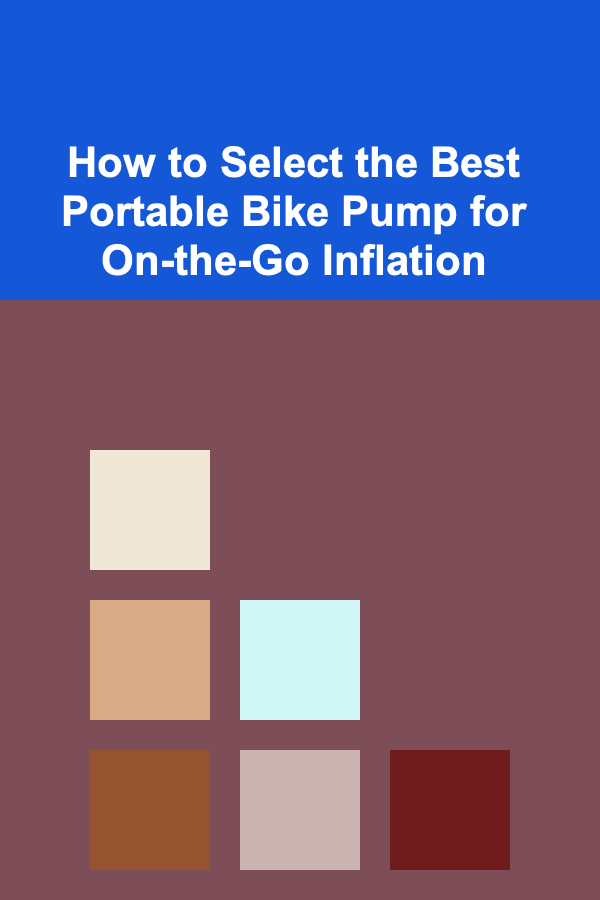
How to Select the Best Portable Bike Pump for On-the-Go Inflation
ebook include PDF & Audio bundle (Micro Guide)
$12.99$6.99
Limited Time Offer! Order within the next:

A flat tire is every cyclist's dreaded companion. Whether you're a seasoned road warrior tackling long distances or a casual commuter navigating city streets, the ability to quickly and efficiently reinflate a tire is paramount. That's where a portable bike pump becomes an indispensable piece of cycling equipment. However, with a vast array of pumps available on the market, choosing the right one can be a daunting task. This article provides an in-depth guide to selecting the best portable bike pump for your specific needs and riding style, covering key factors to consider and offering practical advice to ensure you're always prepared for on-the-go inflation.
Understanding Your Needs: Defining Your Cycling Profile
Before diving into the technical specifications of various pumps, it's crucial to assess your individual cycling profile. This involves considering factors like the type of riding you do, the frequency and duration of your rides, and your personal preferences regarding size, weight, and ease of use. Asking yourself these questions will help narrow down your choices and ensure you select a pump that aligns perfectly with your requirements.
Type of Riding
Different cycling disciplines demand different performance characteristics from a portable pump. Consider these scenarios:
- Road Cycling: Road cyclists typically prioritize lightweight pumps with high pressure capabilities to efficiently inflate narrow, high-pressure tires (often exceeding 100 PSI). Compactness is also desirable for minimizing weight and maximizing aerodynamic efficiency.
- Mountain Biking: Mountain bikers often prefer pumps with larger volumes for inflating wider, lower-pressure tires quickly. Durability is essential to withstand the rigors of off-road riding, and features like flexible hoses can be beneficial when navigating challenging terrain.
- Commuting/Urban Cycling: Commuters and urban cyclists may value pumps that are easy to use and can quickly inflate tires to moderate pressures. Reliability and ease of storage are also important considerations for daily use.
- Gravel Cycling: Gravel riding presents a hybrid scenario, requiring a pump that balances pressure and volume capabilities. Durability is crucial due to the varied and often unpredictable terrain.
- Touring: Touring cyclists need a pump that is both reliable and capable of inflating tires to a variety of pressures, as they may encounter different road surfaces and tire types during their adventures. Durability and ease of repair are also paramount.
Frequency and Duration of Rides
The frequency and duration of your rides will influence the importance of factors like pump efficiency and comfort. If you're a frequent rider who regularly tackles long distances, you'll likely benefit from a pump that requires fewer strokes to inflate your tires. Conversely, if you only ride occasionally for short distances, a more basic pump may suffice.
Personal Preferences: Size, Weight, and Ease of Use
Personal preferences play a significant role in pump selection. Consider these aspects:
- Size and Weight: Do you prioritize a pump that is incredibly small and lightweight, even if it means sacrificing some pumping efficiency? Or are you willing to carry a slightly larger, heavier pump for improved performance?
- Ease of Use: Some pumps are easier to use than others, particularly when it comes to attaching the pump head to the valve. Consider your dexterity and any physical limitations you may have.
- Storage Options: Think about how you plan to carry the pump. Will it be mounted to your bike frame, stored in a saddlebag, or carried in a jersey pocket? The pump's size and mounting options will influence its suitability.
Key Features to Consider: A Deep Dive into Pump Specifications
Once you've defined your cycling profile, you can begin to evaluate the specific features of different portable bike pumps. Here's a detailed breakdown of the most important factors to consider:
Pump Type: Mini-Pumps vs. Hybrid Pumps
Portable bike pumps generally fall into two main categories: mini-pumps and hybrid pumps.
- Mini-Pumps: These are the most common type of portable pump, characterized by their compact size and lightweight design. They are typically hand-operated and rely on a piston and cylinder to compress air. Mini-pumps are ideal for cyclists who prioritize portability and minimal weight. However, they often require more strokes to inflate a tire compared to hybrid pumps.
- Hybrid Pumps (Mini-Floor Pumps): Hybrid pumps combine the portability of a mini-pump with some of the features of a floor pump. They typically have a fold-out footplate that provides stability and allows you to use your body weight to generate more pressure. Hybrid pumps are generally more efficient than mini-pumps, but they are also slightly larger and heavier.
Pressure (PSI) and Volume
Pressure (measured in PSI or BAR) refers to the amount of force the pump can generate, while volume refers to the amount of air it can displace with each stroke. Understanding these concepts is crucial for choosing the right pump for your tire type.
- Pressure: Road bikes typically require higher pressures (80-120 PSI or more) than mountain bikes (25-40 PSI). Ensure the pump you choose has a maximum pressure rating that meets or exceeds the recommended pressure for your tires.
- Volume: Mountain bike tires have a much larger volume than road bike tires. A pump with a high volume will inflate a mountain bike tire more quickly than a pump with a low volume. Look for pumps specifically designed for high-volume inflation if you primarily ride mountain bikes.
Valve Compatibility: Presta vs. Schrader
Bike tires use two primary types of valves: Presta and Schrader. Presta valves are commonly found on road bikes, while Schrader valves are more prevalent on mountain bikes and recreational bikes. Ensure the pump you choose is compatible with your tire valves.
- Presta Valves: These valves are narrower and have a removable valve core. They require a specific pump head that fits securely over the valve and creates an airtight seal. Some pumps have separate Presta and Schrader heads, while others have a dual-head design that accommodates both valve types.
- Schrader Valves: These valves are similar to those found on car tires. They are wider and more robust than Presta valves. Most pumps with a Schrader head will also work on Presta valves, but it's essential to check compatibility before purchasing.
Pump Head Design: Thread-On vs. Lever-Lock
The pump head is the part that connects to the tire valve. Two common designs are thread-on and lever-lock.
- Thread-On Heads: These heads screw directly onto the valve. They provide a secure and airtight connection, but they can be more time-consuming to use, especially in cold or wet conditions. They can also sometimes unscrew the valve core when being removed, leading to deflation.
- Lever-Lock Heads: These heads clamp onto the valve using a lever mechanism. They are generally quicker and easier to use than thread-on heads, but they may not provide as secure of a connection, particularly at high pressures. Look for lever-lock heads with a robust clamping mechanism for optimal performance.
Materials and Durability
The materials used in the construction of a portable bike pump significantly impact its durability and longevity. Consider the following:
- Barrel Material: Aluminum barrels are lightweight and durable, while plastic barrels are less expensive but may be more prone to cracking or breaking. Carbon fiber barrels are the lightest but also the most expensive.
- Handle Material: Look for handles made from durable materials like aluminum, wood, or high-quality plastic with ergonomic designs for comfortable and efficient pumping.
- Internal Components: Check the quality of the piston, seals, and other internal components. High-quality components will ensure reliable performance and a longer lifespan.
Gauge (Optional but Recommended)
A built-in pressure gauge can be incredibly useful for accurately inflating your tires to the desired pressure. While not all portable pumps have a gauge, it's a worthwhile feature to consider, especially for road cyclists who need to maintain precise tire pressures.
- Analog Gauges: These gauges use a needle to indicate pressure on a dial. They are generally more affordable and reliable than digital gauges.
- Digital Gauges: These gauges display the pressure on a digital screen. They are often more accurate and easier to read than analog gauges, but they require batteries and may be more susceptible to damage.
Mounting Options
Consider how you plan to carry the pump and choose a pump with appropriate mounting options.
- Frame Mounts: Many portable pumps come with a bracket that allows you to mount the pump to your bike frame. This is a convenient option for keeping the pump readily accessible.
- Saddlebag/Jersey Pocket: If you prefer to carry the pump in a saddlebag or jersey pocket, ensure it's compact and lightweight enough to fit comfortably.
Additional Features
Some portable pumps come with additional features that can enhance their functionality and convenience.
- Flexible Hose: A flexible hose can make it easier to attach the pump head to the valve, especially in tight spaces. It also reduces the risk of damaging the valve.
- Dust Cover: A dust cover protects the pump head from dirt and debris, which can prolong its lifespan and ensure reliable performance.
- CO2 Inflator Compatibility: Some pumps are designed to work with CO2 cartridges for rapid inflation. This can be a useful option for racing or emergency situations. Consider this if you are already using or considering using CO2 cartridges.
Top Portable Bike Pump Recommendations: A Curated Selection
While specific recommendations will vary based on individual needs and budget, here are some highly-regarded portable bike pumps across different categories:
For Road Cyclists:
- Lezyne Road Drive: A compact and lightweight mini-pump with excellent pressure capabilities. Known for its high-quality construction and efficient pumping action.
- Topeak RaceRocket HP: Another popular choice for road cyclists, offering a good balance of size, weight, and performance. Features a reversible Presta/Schrader head.
- Silca Impero Ultimate: Premium mini-pump known for its exceptional craftsmanship, durability, and efficient inflation. A significant investment, but built to last.
For Mountain Bikers:
- Lezyne Micro Floor Drive HVG: A hybrid pump with a fold-out footplate for added stability and leverage. Ideal for inflating high-volume tires quickly.
- Topeak Mountain DA G: A durable and reliable mini-pump with a high-volume design specifically for mountain bike tires. Includes a built-in pressure gauge.
- Blackburn Mammoth 2FL: Robust construction and high-volume output make this a great option for tackling tough terrain.
For Commuters/Urban Cyclists:
- Topeak Mini Dual DXG: A compact and versatile mini-pump with a reversible Presta/Schrader head and a built-in pressure gauge.
- Pro Bike Tool Mini Bike Pump: A budget-friendly option that offers good performance and reliability for everyday use.
- Lezyne Grip Drive HV: Offers a comfortable grip and high-volume inflation suitable for urban environments.
For Gravel Cyclists:
- Specialized Air Tool Comp Mini Pump: A good all-rounder that balances size, weight and inflation efficiency for both road and off-road use.
- Crankbrothers Sterling LG: Well-built mini-pump with a high-volume mode for lower pressure tires and a high-pressure mode for road tires.
- Lezyne Pocket Drive HV: Compact and efficient high-volume pump ideal for quickly inflating gravel bike tires.
Tips for Using a Portable Bike Pump Effectively
Even the best portable bike pump won't be effective if it's not used correctly. Here are some tips to ensure you can quickly and efficiently inflate your tires on the go:
- Practice Makes Perfect: Before heading out on a ride, practice using your pump at home. This will familiarize you with the pump's operation and allow you to troubleshoot any potential issues.
- Secure the Valve: Ensure the pump head is securely attached to the valve before you start pumping. A loose connection will result in air leakage and wasted effort.
- Use Proper Technique: Use a smooth and consistent pumping motion, engaging your arms and legs for maximum leverage. Avoid jerky or abrupt movements, which can damage the pump.
- Check the Pressure: Use a pressure gauge to ensure you're inflating your tires to the correct pressure. Overinflation can lead to blowouts, while underinflation can increase rolling resistance and the risk of pinch flats.
- Keep Your Pump Clean: Regularly clean your pump to remove dirt and debris, which can affect its performance. Lubricate the piston and seals as needed.
- Carry a Spare Tube: Even with a reliable pump, a flat tire can sometimes be irreparable. Always carry a spare tube and tire levers for emergencies.
Conclusion: Choosing the Right Pump for Your Cycling Adventures
Selecting the best portable bike pump for on-the-go inflation is a crucial decision that can significantly enhance your cycling experience. By carefully considering your cycling profile, evaluating the key features of different pumps, and following the tips outlined in this article, you can choose a pump that perfectly aligns with your needs and ensures you're always prepared for unexpected flats. Remember that investing in a high-quality, reliable pump is a worthwhile investment that will provide you with peace of mind and keep you rolling smoothly on your cycling adventures.

How to Choose the Right Lighting for Your Home's Outdoor Spaces
Read More
How to Create a Checklist for Community Engagement in Event Promotion
Read More
How to Handle Property Maintenance and Repairs
Read More
How to Involve Your Family in Budgeting Discussions
Read More
How to Plan a Spa Day Party at Home for Friends
Read More
Cultivating Temperance in All Things: A Journey Towards Balance and Fulfillment
Read MoreOther Products

How to Choose the Right Lighting for Your Home's Outdoor Spaces
Read More
How to Create a Checklist for Community Engagement in Event Promotion
Read More
How to Handle Property Maintenance and Repairs
Read More
How to Involve Your Family in Budgeting Discussions
Read More
How to Plan a Spa Day Party at Home for Friends
Read More